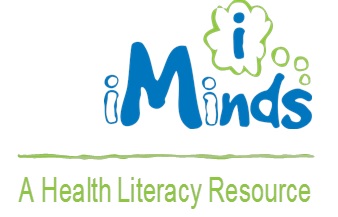Like many teachers, I suspect, I struggled to find engaging and effective learning resources which address substance use for my middle-school students. At first I tried some of the statistic-heavy, scare-based sorts of resources, but they did little to engage the crew I was teaching (or me for that matter!)
One day I had a conversation with a colleague who told me about the “iMinds” learning resources that he had been successfully using with his grade 7 class. I was intrigued  by what I heard and decided to give them a try. Three years later, I’m continuing to use them and adapt them in a way that meets the needs of my classes and, better yet, address multiple learning outcome areas for Health, Science, Math, English and Socials – a bonus for a busy teacher and a packed curriculum! Here’s why I’m continuing to use “iMinds”:
by what I heard and decided to give them a try. Three years later, I’m continuing to use them and adapt them in a way that meets the needs of my classes and, better yet, address multiple learning outcome areas for Health, Science, Math, English and Socials – a bonus for a busy teacher and a packed curriculum! Here’s why I’m continuing to use “iMinds”:
Relationships! It is important to me that I do all that I can to help set a tone that creates a caring, supportive classroom culture. An honest, engaging approach to addressing the topic of substance helps.
Engaged learners! Let’s face it – if we can’t reach them, we can’t teach them! The constructivist approach that “iMinds” uses helps engage students in a far more meaningful manner, one that caters to deeper learning and understanding about substance use and the complex array of factors that influence human behaviour.
No expert required! Thankfully, I no longer feel the need to memorize random stats and facts about drugs and substance abuse. What I am good at – and what matters most for meaningful learning – is setting a context for inquiry and “iMinds” helps me do that with very little extra work on my part. Visiting presenters don’t know “my kids” like I do – and certainly aren’t as readily available to them should they need someone to talk with. As the consistent adult in the classroom throughout the year, I’m happy it’s me who is having the regular candid conversations we do.
Collaboration! Not only do the activities in “iMinds” feature plenty of collaborative learning experiences for my students, but for teachers too. This past year, my grade 8 teaching partner wasn’t very comfortable talking about substance use because she didn’t have any formal training and didn’t feel she was an “expert”. We decided to put our two classes together, so that I could lead the discussions. Once she saw how “unscary” it was she quickly gained confidence in her ability to get our students talking.
Let’s get them talking! Our favorite part about our iMinds lessons was how our students led the discussions on their own without much prompting from us. Our kids loved selecting and developing their research topics and did an impressive job of presenting and discussing their findings with their peers. During and after the presentations, we got authentic questions, comments and discussions from our group. My colleague and I could not have been more proud of how comfortable our gang was with talking about healthy life choices with their peers.
It’s “ready, set, go” and in French too! Everything I need is provided and in a format that I can teach from directly. No need to tweak or retype. Its cross-curricular nature not only helps extend the learning across the subject areas, it helps me cover the learning outcomes that are provincial curriculum requirements. The big bonus for me and my teaching partner is that we can do so en français. We are excited to start this year’s health lessons and combine our various curricular areas so that our students have high engagement and no mindless busy work. We will be able to devote even more time to our iMinds unit this year because we now know how we will combine the learning outcomes across the curriculum and focus on meaningful conversations in French. For us, iMinds is a homerun!
Author: Jen Gibson teaches grade 8 at École John Stubbs Memorial School in Colwood BC. You can reach her at jgibson@sd62.bc.ca.
**Please note that the material presented here does not necessarily imply endorsement or agreement by individuals at the Centre for Addictions Research of BC.

Jen Gibson’s article presents some great ideas when it comes to youth and education around substance use. What concerns me is that schools are trying to or being forced to be all to everyone. Having teachers present curriculum on topics that are community based may be closing some doors instead of opening them. Bringing in guest speakers and experts in the field of study not only introduces youth to a wide variety of resources but also connects them to their community. If a student faces a substance use issue in later years, and has been connected to people outside of the school environment, they are more likely to connect with that outside resource sooner than later. This may even be necessary over the summer months when school is not in session. Students who have not had that connection may delay taking action due to the unknown fear factor. Making sure youth know all the options available and connecting them to those options early on gives way to more healthy relationships with other community agencies.
Hi,
Do you folks have any info re senior’s and substance abuse?
Thanks
Sara
Sara Himelstein MSW RSW
Kidney Care Clinic Social Worker
Royal Jubilee Hospital
1952 Bay Street
VIctoria BC V8S 1JR
Tel: (250) 370-8111 x12401
Fax: (250)370-8579
Sara.Himelstein@viha.ca
Thanks for the great question Sara!
Here are a few links you might find useful:
http://www.nicenet.ca/tools-introduction-to-older-adults-and-substance-use
http://knowledgex.camh.net/amhspecialists/resources_families/Pages/older_adults_alcohol.aspx
http://www.camh.ca/en/education/about/camh_publications/Pages/improving_response_olderadults.aspx